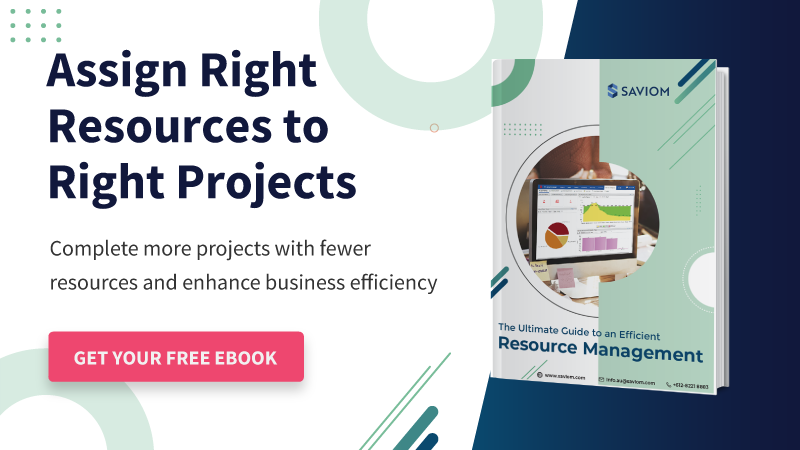Organizations acquire a talented resource pool that can lead projects to success, but is that enough? One should not overlook the importance of managing resources effectively as it is the key to achieve the desired success.
Without efficient resource management, the workforce will only end up making efforts without getting the desired results.
For example, the workforce in a matrix organization has to work on different projects under multiple reporting lines. In such a complex structure, the active resources will receive critical tasks and operate beyond their capacities. In contrast, less visible employees may remain underutilized.
Moreover, it reduces billable utilization because competent resources may keep working on non-billable projects due to lack of visibility. This leads to hiring new employees abruptly as project leaders find everyone unavailable when the requirement of resources arises. When the projects end, rolled-off resources will serve bench time or even face a layoff.
There are many scenarios where a talented workforce cannot achieve project success due to improper planning. With effective resource management best practices, you can increase business profitability with the existing resource pool. Let us go through some of these methods to make the best use of resources.
Eliminate silos with centralized resource scheduling
An organization functions with a diverse workforce in different departments, teams, locations, etc. It creates silos and leads to a lack of visibility. In this case, resource managers will have to search every hierarchical channel whenever the need for a particular skill arises.
The resource manager will not be able to view their bookings. Ultimately, they will not be able to allocate resources on the project at the right time despite having sufficient talent.
Centralizing resource details like their departments, location, skill sets, competencies, etc., and their schedule helps maintain a single source of truth. Also, it establishes transparency of resource bookings, task ownership, and engagement period. Finally, anyone can find resource details easily and create resource plans without wasting time.
Encourage resources to acquire multiple skills
In multi-project organizations, employees have to take up different roles at times. It means they not only take up the projects matching their primary skills but also as per their secondary skills.
When team members possess primary and multiple secondary skills, they can be easily made billable.
Every employee in the resource pool may not have the necessary skills to take up different roles. Secondary skills can be learned on the job with some training and support from the management. Ultimately, allocating them to various projects becomes easier and organizations can make efficient use of the resources in the workplace.
Read More: What is Resource Planning, and Why is it Important in Project Management?
Facilitate Bench Management effectively
When a project finishes and the next one begins, some employees serve the bench time until the resource manager finds a suitable job for them. Lead time to find a new assignment increases the costs and affects the bottom line of the organization.
Visibility of a rolled off date enables the resource manager to aggressively look for opportunities in advance. It helps minimize the resources’ bench time. Also, the organization can conduct employee training programs for the resources that are partially or completely available.
Read More: Understanding Resource Availability within Project Management
In this manner, an enterprise can invest in nurturing employees to acquire additional skills. Training the existing workforce along with shadowing opportunities on a billable project further reduces bench time.
Forecast pipeline project demands and act
One way of increasing productivity is accurately forecasting and addressing the demands coming from the pipelined projects. Whenever the pipelined project reaches a certain probability of closure, the resource manager can start resource planning. One should conduct accurate workforce capacity planning by measuring the available capacity against the project demand.
It helps identify the excesses or shortages and helps mitigate with necessary measures. In the case of resource shortages, hiring a contingent workforce addresses the short-term project demands. For long-term demands hiring permanent employees can be a solution. If resources are in excess then you can adjust project timelines and manage the underutilized resources effectively.
Read More: What is Resource Forecasting? An Ultimate Guide for Project Managers
Increase billable resource utilization
Resources must be primarily allocated to billable or strategic projects to optimize overall utilization. Avoid under or overbookings that can adversely affect the utilization of the organization or cause employee burnout.
Distribute your key resources across all the projects and do not assign them to only specific priority projects. Compare the forecasted and actual time to schedule billable hours to ensure that there is no billing loss. Adapt a multi-location policy and deploy generic resources from low-cost locations to control cost and increase profitability.
Allocate resources to projects as per skills and interests
Maintain an enterprise-wide workforce database that contains individual skills and competencies. Considering them along with the personal interests of employees so that you can allocate them to the projects of their interests.
This practice boosts employee engagement that results in higher productivity. Also, there are other benefits such as more creativity, proactive participation, managing task ownership appropriately, etc.
Read More: Resource Allocation: A Guide on How to Apply it to Project Management
Use real-time business intelligence for informed decision making
The efficient way of managing resources is by tracking the key performance indicators (KPIs). These can be over or underutilization, availability, capacity, task engagement, and more. Decision-makers can make effective and efficient use of resources if they get real-time updates of the KPIs.
Role-based view helps stakeholders access relevant data and avoids information overloading. With that information, the project leaders can effectively manage resources by monitoring the real time changes, evaluating risks, and identifying opportunities.
The Glossary:
Read More: Glossary of Resource Workforce Planning, Scheduling and Management
Saviom Solution
SAVIOM is the market leader in providing effective solutions for managing enterprise resources efficiently and effectively. With over 20 years of experience, Saviom has addressed the business needs of many highly-esteemed global companies. Some of the tool’s components include enterprise resource management, professional service automation, and workforce planning software.












